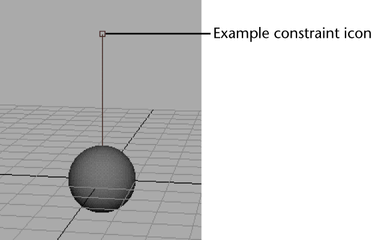After
you create a constraint, Maya creates a constraint named for the
type of constraint. For example, rigidNailConstraint1 is the default
name given to a Nail constraint. To adjust
a constraint’s attributes in the Attribute Editor,
you must first select the constraint in the Outliner or
the constraint icon in the workspace.
NoteThe Rigid
Constraint Attributes section of the Attribute
Editor displays read-only Force and Solver
Id attributes. The Force shows the X, Y, and Z components
of the current force pulling towards one or both objects connected
to the constraint. The Solver Id is
the constraint index number the solver uses to calculate dynamics
for this constraint. You can query the value of these attributes
in expressions and MEL commands.
Adjust the initial position
and orientation
You
can adjust the initial position of all rigid body constraints. You
can adjust the initial orientation of only Hinge and Barrier constraints.
To adjust a constraint’s position
- Do one of the following:
- Use the Move tool
to drag the constraint icon.
- In
the Rigid Constraint Attributes section
of the Attribute Editor, enter X,
Y, and Z values for Initial Position.
TipIf you move a constraint
in a frame other than the starting frame, rewind to make the constraint
animate properly.
To adjust a Hinge or Barrier constraint's
initial orientation:
- Do one of the following
- Use the Rotate tool
to rotate the initial orientation icon.
- In the Rigid Constraint Attributes section
of the Attribute Editor, enter X,
Y, and Z values for Initial Orientation.
Change or turning off the
constraint type
You
can change the constraint type or turn a constraint off or on after
you create it. Before you change the constraint type, be aware of
these issues:
- You cannot change a single-body constraint
to a dual-body constraint.
- If you change the constraint type, the
constraint name doesn’t change.
- A Nail or Barrier constraint
cannot constrain a passive rigid body.
- You cannot constrain two passive rigid
bodies to each other.
To change the constraint type
- In the Rigid Constraint Attributes section
of the Attribute Editor, select the
constraint type from the Constraint Type menu.
To turn a constraint off (or on)
- In the Constraint Control section
of the Attribute Editor, set these
attributes:
- Constrain
-
Turns
a constraint on or off.
Relative To
For
a constraint between a pair of rigid bodies, this lets you choose
where Maya recreates a constraint after you turn it on again. Your
choices follow:
- Body 1
-
Recreates the
constraint at the original distance and orientation from the first
of the two rigid bodies you selected when you created the constraint.
- Body 2
-
Recreates the constraint at
the original distance and orientation from the second of the two
rigid bodies you selected when you created the constraint.
- Mid Point
-
Recreates the
constraint at the midpoint between the two rigid bodies.
- User Defined
-
Lets
you specify the position in the User Defined Position
X, Y, and Z boxes.
These attributes are dim unless you turn on User
Defined.
Example
Suppose you create a
pin constraint between two objects. The pin is positioned as follows.
The small square represents the pin’s location.
Before making the pin
constraint, the sphere was selected first and the cylinder second.
In the context of the Relative To attribute,
the sphere is therefore Body 1 and
the cylinder is Body 2.
You then animate the
movement of the cylinder in a direction perpendicular to the constraint
line icon. The constraint forces the sphere to swing around the
cylinder. If you key Constrain off for several frames,
the sphere is no longer constrained to the cylinder. It moves in
its own direction using the force previously applied to it by the
constraint.
When you key Constrain on
again in a later frame, the sphere will once again be tied to the
cylinder. You can set the location and orientation of the pin by
setting the Relative To attribute. This
influences how the objects interact with each other’s movement.

